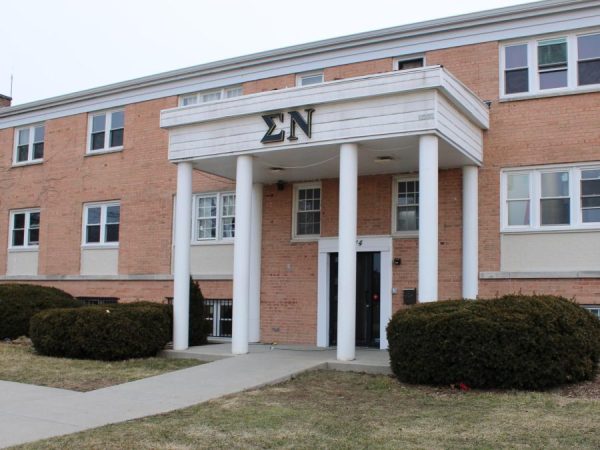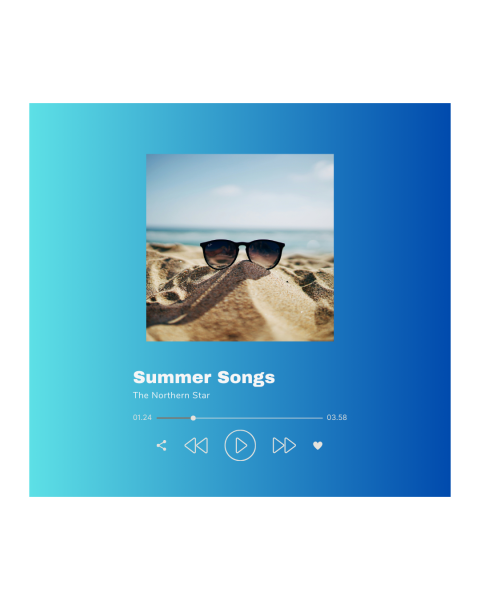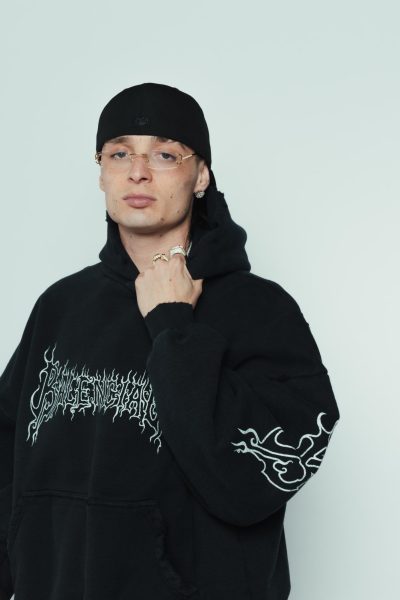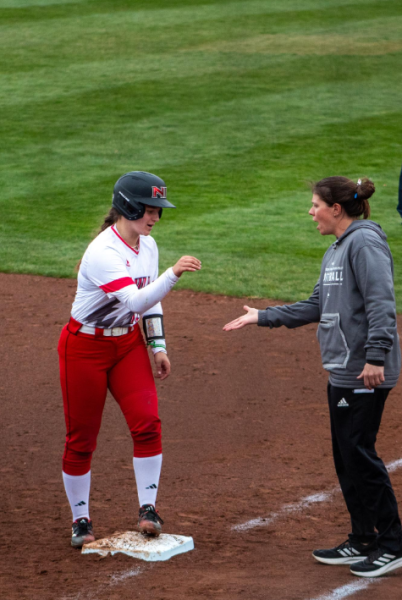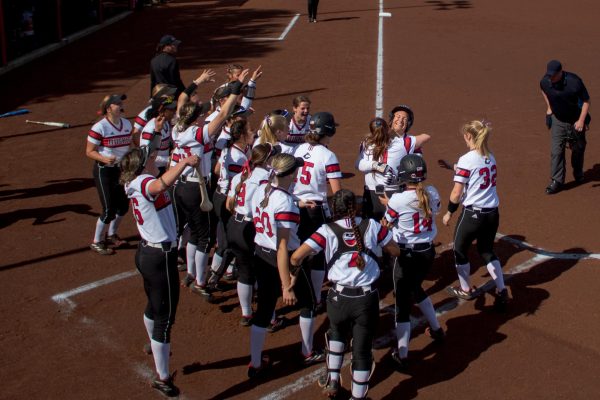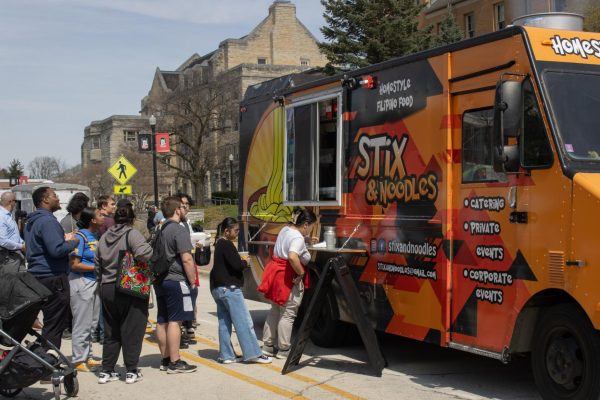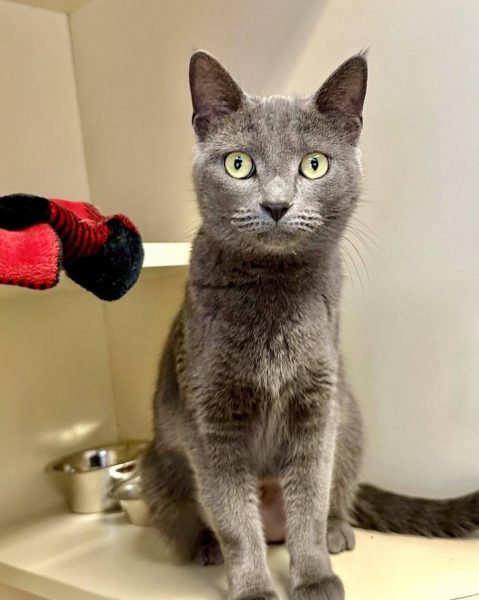Postcards from DeKalb: Artists reminisce
February 6, 2013
Thousands of people have gone through DeKalb. Some stay for four years, others a lifetime. However, one thing remains the same: DeKalb is rich with history and has a story that warrants being told. The summer of 1999, a group of artists and volunteers collaborated to tell that story through art.
The project did not have the most conventional start.
Altgeld Hall was closed for renovations in 1999, leaving the NIU Art Museum without a home.
“And we wanted to get paid,” said Pete Olson, assistant director for the NIU Art Museum.
So the people who worked for the museum found something to do. The NIU Art Museum began working on a new project for the City of DeKalb: “Museum Without Walls.” With the completion of many grand scale projects, the entire city became an artist’s playground and DeKalb became its own museum.
Projects began all over the city, but the most infamous is the mural that Olivia Gude, professor at University of Illinois at Chicago, worked on. She was contacted by the NIU Art Museum to work on the project. Gude is from the Chicago land area and had worked on many mural projects. Gude was the head artist for the DeKalb mural, “Its Merits Recommend It…” Located on the corner of Lincoln Hwy. and First St., “Its Merits Recommend It…” is a mural that tells the story of DeKalb. The name for the mural hails from an old slogan for barbed wire.
Meetings and focus groups were held to determine the pieces of the mural. Locals were interviewed for their input and suggested iconic symbols like Altgeld Hall and a DeKalb sunset. Both were incorporated into the mural on a postcard. At these meetings, old postcards with images of DeKalb were presented to the artists, and a postcard theme was born.
“We just had so many resources to pull from,” Gude said.
The mural’s main artists knew it would take a lot of time, money and paint to cover the entire wall, so they decided to work with the bricks instead of against them. Thinking about history, they worked with a postcard concept to represent the stories and images of DeKalb’s past.
The ideas poured in and work began in June.
“It was a very thoughtful process,” Olson said. “Everything has at least one reason why it’s there. Sometimes it has many.”
Uncovered History
The group was in for a surprise when they took down an advertisement sign to work on the project. A pool hall was located in the building at the time, and they received permission to take the sign down. Behind the sign was something they had not anticipated: Remnants of a DeKalb Daily Chronicle sign, the original owner of the building, remained on the brick wall. The Chronicle building was owned by Joseph Glidden in the late 1800s. The group liked the surprise and kept the piece in because it related to the mural about DeKalb’s history.
“We just worked it into the design,” Burke said.
Barbed Wire Builders
A DeKalb mural wouldn’t be the same without the three men who put the city on the map: the inventors of barbed wire. Although Isaac Ellwood, Joseph Glidden and Jacob Haish had their differences throughout the years (partnerships, lawsuits and more), they are depicted together on a postcard.
Glidden and Corn
By putting Annie Glidden on the mural, the artists truly put a face to the name.
“Everyone knows Annie Glidden Road,” Olson said. “Now they know Annie.”
Annie Glidden was niece to the “Father of Barbed Wire,” Joseph Glidden, but to some she was much more than that, including an agricultural pioneer. Glidden was a promoter of culture and social causes, according to the Glidden Homestead website.
“She was a strong, intellectual female,” Olson said.
Having a female represented provides a new spin on DeKalb’s history, which usually focuses on Haish, Joseph Glidden and Ellwood, Olson said.
To create Annie Glidden’s face was a project of its own. The group wanted to paint a young but wise Glidden, and a photo like that of her did not exist.
“We weren’t able to dig one up,” Burke said.
The only photos the artists had to work with showed Glidden as a young girl or as an older woman. Artists visited Glidden’s niece and nephew at Oak Crest DeKalb Area Retirement Center to talk about Glidden’s life. With the photos they did have and the information they gathered from research, the artists created what they believed to be an image that showed Glidden at her prime.
However, Glidden’s likeness receives a lot of flak to this day, from her stature down to the boots on her feet.
“Some critics say she would have been wearing more ladylike shoes,” Burke said. “Something with a small heel.”
Other critics draw attention to Glidden’s face and body structure.
“People would ask, ‘Who’s the guy on the wall?’” Olson said.
However, Glidden seemed to be an inspiration to Gude, the lead artist.
“I think Olivia liked the strong woman,” Burke said. “She was a woman that wasn’t overly foofy.”
A close-up view of Glidden’s dress reveals a pattern: barbed wire and ears of corn.
The corn stalk Glidden stands beside was a challenge in itself. After all, the artists were concerned that if anyone was to notice an error, it would be a local from the land of corn. The artists researched stalks of corn and wanted to use an actual stalk for reference. However, no one was coming forward to donate a stalk of corn and a couple of volunteers took the matter into their own hands.
“Two guys had gone out one night and stolen a stalk of corn,” Gude said.
Finally, there is a spot of dirt at Glidden’s feet. However, it isn’t just dirt; it’s the rich soil that one can only find in northern Illinois, Olson said.
“It may just look like a dark spot,” Olson said. “But it’s part of the identity of this place.”
The Mighty Kish and the Husky Dog
It was about 100 years prior to the mural’s completion when the Illinois State Legislature was looking for a site for a teacher’s college.
The three barbed wire inventors wanted to bring the school to DeKalb. To make this happen, the community worked together to make the Kishwaukee River look large and strong, something it wasn’t known for previously. Water was preserved and the river was dammed in order to make the river look suitable.
The rest is history, and today DeKalb is home to NIU. The image of the river depicted in the postcard on the mural is that of a wide, flowing river. A young boy who is fishing on the “mighty” Kishwaukee is joined by his companion, a husky dog.
“These are some of the elements that you can only appreciate up close,” Olson said.
Faces of DeKalb
Many faces are featured on the wall, though they aren’t as obvious as Glidden’s. The images are from yearbook photos of actual students from DeKalb and NIU.
The artists picked a man and a woman from every decade to represent the years of DeKalb, and the faces are scattered throughout the mural. Even supermodel and DeKalb alumna Cindy Crawford’s high school yearbook photo makes an appearance on the wall.
“She was just as beautiful then,” Olson said.
Portrait of a Past Post Office
The former DeKalb Post Office was located across from the location of the mural, where Walgreens currently stands.
The post office was torn down in 1995, but remnants still remain in the area.
A piece was salvaged: a balustrade from the building. The piece is located in front of the mural and serves as a reminder of the historic building that once stood across the street.
Olson said the writing on the post office postcard says “I hope you were here” as a testament to the building.
Memories of Altgeld Auditorium
The Altgeld postcard on the mural is hardly an image of the Altgeld Hall that was being renovated in 1999.
Instead, an image of the original Altgeld auditorium shows how much the size of the school has changed. A daily assembly was held in the Altgeld auditorium, “probably in the 1920s,” Olson said.
Students had assigned seating in the auditorium. With an arrow pointing to a specific seat, the postcard reads “Where I sit. Nothing new. Be home Thursday instead of Friday.”
“This was a joking reference to NIU students saying that there is ‘nothing to do in DeKalb,’” Gude said.
Dear Mom: Love, Olivia
Gude truly left her mark on the mural in a credit box: a postcard addressed to her mother that detailed the work and contributions that went into the mural. Artists, sponsors, designers and painters are all recognized.
“This was also a reference to the town and community,” Burke said. The stamp on the postcard is of Abraham Lincoln, representing the mural’s location on Lincoln Highway. The time stamp is Aug. 6, 1999–the date the mural was completed.
14 Years Later
The community was very receptive to the idea of the mural. Olson described the project as a “great partnership” between the town and the university.
“People would come and watch us work,” Gude said. “We were working in the summer and people would bring us bottles of water.”
Sometimes, citizens would be invited to sit on top of the scissor lift that the artists used for reaching the higher points of the mural. When the artists took breaks, they would sit and view the city from 50 feet in the air.
“We would just relax and look at the town,” Gude said.
By day, the group would work in the heat and the acrylic paint would dry quickly.
“This wasn’t a color by numbers,” Olson said. “We learned a lot, like the brick wall was like the surface of the moon.”
The heat made for long days.
“The hot brick was like working inside of an oven,” Olson said.
It was a challenge for the group to work those long days and late into the night. When the sun went down, the group used overhead projectors to cast images and outlines onto the wall to create the mural that is recognized today.
Being located near a four-way stop, people pass by the art every day. However, getting out of the car and getting close to the mural may reveal things that may not be noticed by people during their daily commute.
“The more attention you pay to it, the more rewarded you are,” Olson said.



